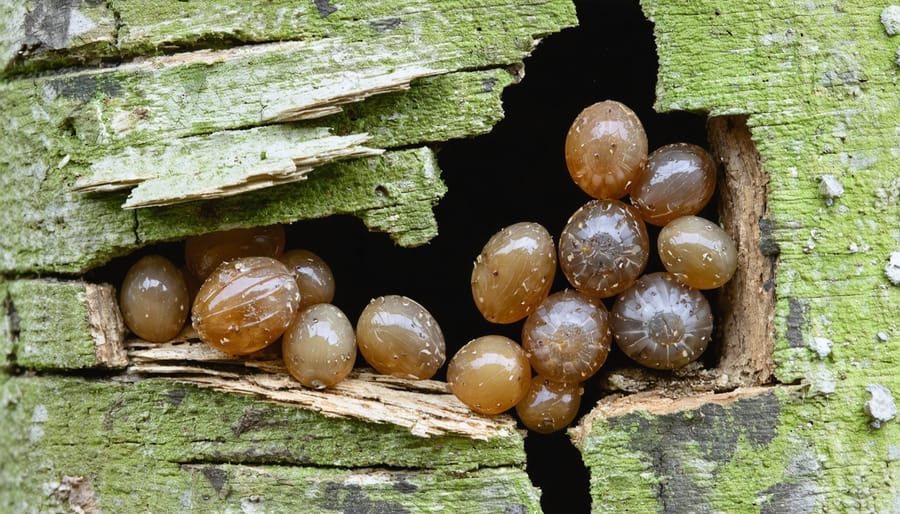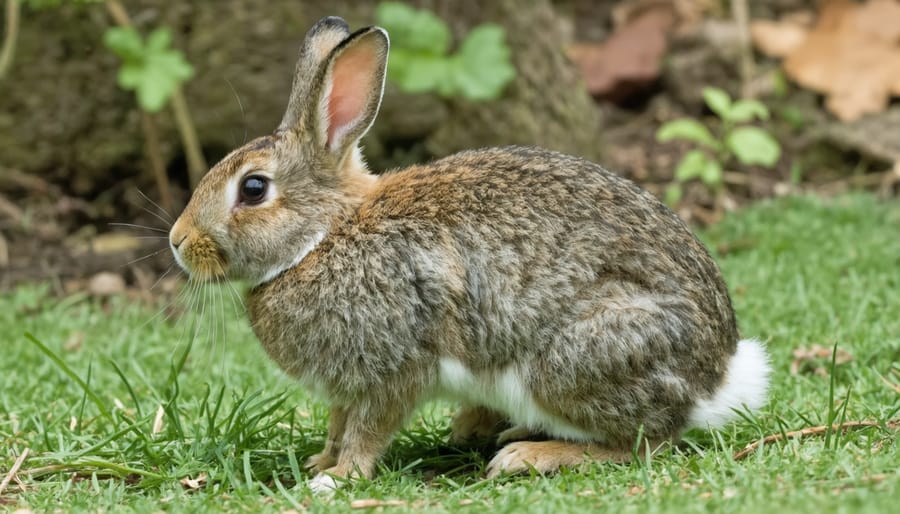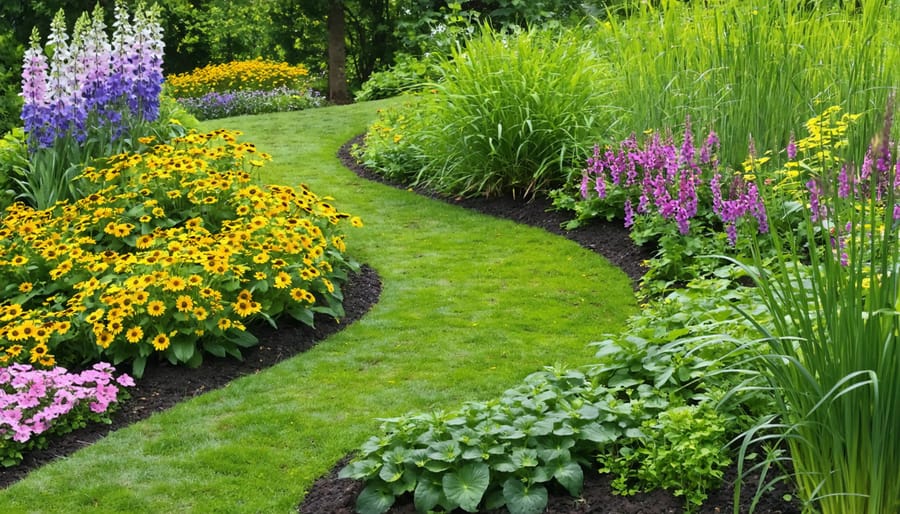Winter doesn’t put pests on pause—it simply changes which creatures threaten your perennial garden. Aphids shelter in plant crevices, voles tunnel beneath snow cover to feast on roots, and fungus gnats thrive in the moist soil of overwintered containers. The cold months offer your best window for breaking pest cycles before spring’s explosive growth begins.
Inspect your garden beds on milder winter days, checking for tell-tale signs like chewed bark at soil level, raised tunnel lines in mulch, or clusters of overwintering eggs on plant stems. Remove these breeding grounds now, and you’ll prevent hundreds of pests from emerging when temperatures rise. Many gardeners overlook this crucial timing, then wonder why they battle the same infestations year after year.
Clear away dead foliage that harbors pest eggs and disease spores, but leave some plant stems standing—beneficial insects like ladybugs need winter shelter too. This selective cleanup protects your garden allies while eliminating pest habitat. Apply horticultural oil to dormant woody perennials on days above 40°F to smother scale insects and mite eggs without harsh chemicals.
Set hardware cloth barriers around prize perennials to block vole damage, burying the mesh four inches deep and extending it eight inches above ground. These simple physical defenses work through the harshest weather when sprays prove ineffective.
Winter pest control isn’t about perfect elimination—it’s about reducing populations to manageable levels before the growing season demands your attention elsewhere.
Why Winter Pest Control Matters for Your Perennials
You might think pests disappear when temperatures drop, but the truth is far more complex—and understanding it could save your perennial garden from significant damage come spring. While winter feels quiet in the garden, beneath the surface and tucked into cozy hiding spots, countless pests are simply waiting for warmer days.
Most garden pests don’t actually die off in winter. Instead, they’ve evolved remarkably clever survival strategies. Aphids, for example, lay cold-hardy eggs on perennial stems and woody growth, where they’ll remain dormant until spring temperatures trigger hatching. Spider mites overwinter as adults in soil crevices and under mulch, particularly around the crowns of your favorite perennials. Slugs burrow deep into the soil or hide under leaf litter, where they’ll survive freezing temperatures in a state of reduced activity.
This dormancy period is actually when these pests are most vulnerable. During winter, they’re stationary, making them easier to manage than during their active growing seasons. If you’ve spent time identifying destructive pests in your garden during warmer months, winter offers the perfect opportunity to break their lifecycle before they reproduce.
Here’s why this matters: a single overwintering aphid population can explode into thousands within weeks of spring warmth. Those dormant spider mite eggs? Each female can lay hundreds of eggs throughout the season. By addressing pest populations now, you’re preventing exponential growth that could overwhelm your plants when they’re most vulnerable—during spring’s tender new growth phase.
Think of winter pest control as an investment in your garden’s future. The science is clear: interrupting pest lifecycles during dormancy significantly reduces populations for the entire growing season. This proactive approach means less chemical intervention later, healthier perennials, and more time enjoying your garden rather than battling infestations. Plus, winter management aligns beautifully with sustainable gardening practices, as you’re working with natural cycles rather than against them.
The Usual Suspects: Common Winter Garden Pests
Overwintering Insects and Eggs
While your perennial garden sleeps beneath the snow, tiny troublemakers are hunkering down for the long haul. Think of winter as a game of hide-and-seek where the pests have gotten really good at hiding. The good news? Once you know their favorite spots, you can outsmart them before spring arrives.
Aphid eggs are surprisingly tough customers. These glossy black specks, barely visible to the naked eye, cling to bark crevices and the undersides of branches. A single overwintering egg cluster can launch hundreds of aphids come spring, so it’s worth grabbing your reading glasses for a close inspection of your roses, fruit trees, and perennial stems.
Scale insects take winter dormancy to another level. These armored pests look like tiny bumps on branches and stems, and honestly, I’ve mistaken them for natural bark texture more times than I’d like to admit. They’re particularly fond of euonymus, hollies, and fruit trees. Run your fingernail along suspicious bumps; scales will scrape off while natural bark won’t budge.
Spider mites often go unnoticed because they’re incredibly tiny, but their webbing gives them away. Check the undersides of evergreen leaves and in the joints where branches meet. These overwintering adults wake up hungry and ready to reproduce rapidly once temperatures rise.
The secret weapon against all these winter squatters? A thorough cleanup combined with horticultural oil applications during mild winter days above 40 degrees Fahrenheit. This one-two punch disrupts their cozy winter hideaways before they become spring disasters.

Active Winter Pests
When winter settles in and natural food sources become scarce, several furry visitors may start eyeing your garden as their personal buffet. I learned this lesson the hard way when I discovered mysterious paths through the snow leading straight to my prized shrubs!
Voles and mice become surprisingly bold during winter months. These small rodents create networks of tunnels beneath the snow, gnawing on tree bark, bulbs, and roots without you even seeing them. The damage often doesn’t show up until spring thaw, when you notice girdled stems and missing plants. They’re particularly fond of fruit tree roots and the tender bark near the base of young trees.
Rabbits shift their diet from tender greens to woody stems when temperatures drop. You’ll recognize their work by the clean, angled cuts on branches and the damage that typically occurs up to about two feet off the ground (or higher if there’s deep snow). They love young fruit trees, shrubs, and perennial stems left standing for winter interest.
Deer become increasingly desperate as winter progresses, and they’ll eat plants they normally ignore during other seasons. Those beautiful ornamental grasses and evergreen shrubs you thought were safe? They’re fair game when hunger strikes. Deer browsing shows as ragged, torn edges rather than clean cuts.
The key to managing these winter pests is understanding their behavior patterns and implementing protection strategies before they discover your garden. A little prevention now saves a lot of heartache come spring.

Fungal and Disease Carriers
Winter isn’t just a quiet time for pests—it’s often when they’re silently spreading trouble through your garden. Many overwintering insects and larvae carry fungal spores, bacteria, and viruses on their bodies, tucking them into plant debris, soil crevices, and dormant stems. When spring arrives, these diseases emerge alongside hungry pests, creating a double threat to your perennials.
I learned this lesson the hard way when aphids sheltering in my garden’s leaf litter spread a nasty fungal infection to my hostas come April. The key is understanding that winter pests act like tiny disease couriers, moving pathogens from one hiding spot to another. Slugs, for instance, can carry fungal spores in their slime trails, while spider mites often harbor plant viruses. By removing pest habitats and practicing good winter sanitation, you’re not just controlling bugs—you’re breaking the disease cycle before it starts.
Your Winter Pest Prevention Strategy
Early Winter Cleanup (Late Fall to Early December)
Think of early winter cleanup as setting the stage for a healthier garden come spring. This crucial window, typically from late November through early December, is your opportunity to eliminate pest hideouts before winter truly settles in.
Start by removing obviously diseased or pest-damaged plant material. Leaves with fungal spots, stems with egg masses, or stalks showing borer damage should go straight into the trash, not your compost pile. I learned this lesson the hard way when aphid eggs overwintered in my compost and caused havoc the following spring!
However, here’s where mindful cleanup matters. Not everything should be removed. Hollow stems of perennials like Joe Pye weed and native grasses provide essential winter shelter for beneficial insects, including native bees. Leave these standing until early spring as part of your seasonal perennial care routine.
Clear away fallen leaves from around susceptible plants, particularly those that struggled with disease during the growing season. Soggy leaf litter creates perfect conditions for slugs and other pests to hunker down for winter.
Pull spent annuals completely and check your perennial crowns for signs of root weevils or grubs. A gentle inspection now can prevent major problems later. Finally, empty and clean plant saucers and containers where mosquitoes might otherwise lay dormant eggs. These simple steps create an inhospitable environment for pests while protecting the beneficial creatures your garden needs.
Mid-Winter Monitoring and Maintenance
Winter doesn’t mean your garden monitoring duties disappear. In fact, checking on your plants during the coldest months can save you from unpleasant surprises come spring. I like to do a quick garden walkabout every two weeks, even when it’s chilly outside.
Start by inspecting the soil around your perennials, especially near the crowns. Look for disturbed mulch or small tunnels that might indicate vole activity. Check under rocks and debris where slugs and pill bugs like to hide during the day. If you spot soft, mushy plant tissue or signs of chewing on evergreen foliage, you’ve got active pests that need immediate attention.
Physical barriers become your best friends in winter. Burlap wraps protect vulnerable plants from both harsh weather and hungry pests. Hardware cloth cylinders around plant bases keep voles and rabbits at bay without using chemicals. For smaller perennials, even an overturned milk jug with the bottom cut off creates a helpful mini-greenhouse that deters pests.
If you discover active damage, act quickly but thoughtfully. Remove affected plant material and dispose of it away from your garden. For vole runs, stomp them down to discourage further tunneling. Refresh your mulch barriers if they’ve been compromised.
During January’s bitter cold, I interviewed master gardener Elizabeth Chen, who shared this wisdom: “Winter pest control is about consistency, not perfection. Small, regular checks prevent big problems later.” That simple advice has saved countless plants in my own garden over the years.
Late Winter Preparation (February to Early March)
As winter starts loosening its grip, late February through early March becomes your golden opportunity to get ahead of spring pests before they fully wake up. Think of this as your garden’s pre-season training – a little effort now prevents major headaches later.
This is the perfect time to apply dormant oil sprays, one of the most effective and eco-friendly treatments available. These horticultural oils work by smothering overwintering pests like aphid eggs, scale insects, and mite eggs that are still dormant on tree branches and shrub stems. The key word here is “dormant” – you want to apply these treatments before buds begin to swell but when temperatures are above 40°F. I always check the forecast for a mild, dry day to ensure the oil has time to dry properly.
Walk through your garden with a critical eye during these weeks. Remove any remaining leaf litter, prune out dead or damaged branches where pests might be hiding, and check under mulch for emerging slugs. If you spot moss or algae on pots or garden structures, give them a good scrub – these can harbor pest eggs.
Set up physical barriers now, before pests become active. Install copper tape around raised beds to deter slugs, refresh floating row covers, and ensure netting is ready for vulnerable plants. Consider placing beneficial insect houses in sheltered spots to attract pest predators like ladybugs and lacewings as spring arrives.
This preparation phase isn’t glamorous, but it’s incredibly rewarding when you sail through spring with minimal pest pressure.

Sustainable Winter Pest Control Methods
When winter arrives, many gardeners breathe a sigh of relief, thinking pest problems disappear with the first frost. But here’s the thing: choosing sustainable approaches during the dormant season sets you up for success come spring, and it’s easier on your garden’s ecosystem too.
Let’s start with integrated pest management, or IPM for short. This approach is all about working with nature rather than against it. During winter, IPM focuses on prevention and monitoring. Walk through your garden regularly to spot early signs of trouble. Check under mulch, inspect tree bark, and look for egg masses on plant stems. Catching problems early means you’ll need less intervention later.
Physical barriers work wonders in winter. Wrapping tree trunks with burlap or tree guards protects against vole damage and keeps rabbits from gnawing on bark. Floating row covers can shield low-growing perennials from both pests and harsh weather. These methods align perfectly with sustainable pest management principles because they’re reusable and chemical-free.
Horticultural oils deserve a special mention for winter pest control. Applied on mild days when temperatures stay above freezing, dormant oil sprays smother overwintering pests like aphids, scale insects, and mites. The timing is perfect because deciduous plants have dropped their leaves, giving you clear access to pest hiding spots. Plus, these oils break down naturally without harming beneficial insects that emerge in spring.
Companion planting might seem like a warm-season strategy, but planning it now pays dividends. Map out where you’ll place pest-deterrent plants like alliums and herbs next growing season. This forward-thinking approach is central to organic landscaping methods that build resilience over time.
Don’t overlook cultural practices either. Proper spacing improves air circulation, reducing fungal diseases that pests love. Winter is ideal for pruning overcrowded perennials and removing plant debris where pests overwinter. Think of it as tidying up your garden’s neighborhood, making it less inviting for unwanted guests.
Finally, encourage natural predators. Leave some leaf litter in strategic spots to shelter beneficial insects and ground beetles. These garden allies will be ready to tackle emerging pests when spring arrives, creating a balanced ecosystem that largely manages itself.
What Not to Do: Common Winter Pest Control Mistakes
Even the most well-intentioned gardeners can slip up when it comes to winter pest control. Let me share some common mistakes I’ve seen over the years, so you can sidestep them entirely.
First up is the pruning problem. I get it, winter seems like the perfect time to tidy up your garden, but excessive pruning can actually backfire. Those hollow stems and dried seed heads aren’t just eyesores—they’re winter hotels for beneficial insects like ladybugs and native bees. By cutting everything back to the ground, you’re destroying their overwintering sites. Instead, leave some strategic plant debris and save major cleanup for early spring.
Another frequent mishap involves using the wrong products in cold weather. Many organic pesticides and sprays simply don’t work when temperatures drop below 40 degrees Fahrenheit. The oils won’t spread properly, and some can even damage plants in freezing conditions. Save your money and wait for milder days, or switch to physical barriers and manual removal instead.
Here’s a mistake that breaks my heart: accidentally harming beneficial insects. Those papery wasp nests under your eaves? They’re empty, but destroying them means those helpful wasps need to start from scratch next spring. Same goes for brush piles that house ground beetles and spiders, your natural pest control team.
Finally, don’t fall into the trap of assuming winter means no pests. Rodents, slugs, and overwintering aphid eggs are all active or present during cold months. Ignoring winter monitoring means you’ll face an explosion of problems come spring. A quick garden walk every few weeks keeps you ahead of potential issues without much effort.
Winter isn’t a time to hang up your gardening gloves—it’s actually one of your best opportunities to set the stage for spectacular spring blooms. Those small efforts you make now, whether it’s clearing away debris, checking for overwintering pests, or applying dormant oils, are investments that pay remarkable dividends when warmer weather arrives.
Think of winter pest control as giving your garden a head start. By addressing problems while pests are vulnerable and plants are dormant, you’re preventing the exponential growth of insect populations that happens come spring. A few minutes spent inspecting your perennials this month could save you hours of damage control later.
The good news? Winter garden care doesn’t require marathon sessions outside in the cold. Quick checks every few weeks, removing pest hiding spots, and strategic treatments are often all it takes. You’re not just controlling pests—you’re creating the foundation for a healthy perennial garden that thrives year after year.
So bundle up, grab your favorite gardening tools, and take advantage of this quieter season. Your future self—and your beautiful spring garden—will thank you for the effort.




